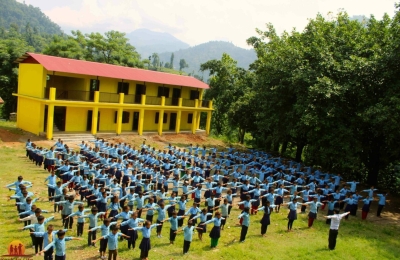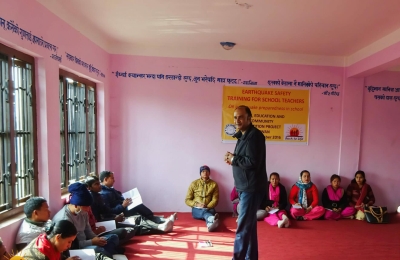There are two winters in Nepal

Hemanta & Shishir
Nepal has 6 seasons to offer
Once you have been to Nepal, you will probably never forget the country. It’s wonderful. The nature is incomparable from the lowlands in the south, the Terai, which is only 70 meters above sea level, to the highlands in the north, which include Mount Everest as the highest point in the world. The altitude rises slowly, making Nepal an extremely geographically diverse country.
The diversity is also reflected in the six seasons:
– Winter: Shishir
– Spring: Basanta
– dry summer: Grishma
– Late summer with monsoon rains: Barshaa
– Autumn: Sharad
– Pre-winter: Hemanta
The seasons as well as the geography of each place shape the social and cultural life of the people.
Winter has several challenges
What is simply called winter in the West, actually encompasses two seasons in Nepal: Hemanta, the one with snow, and Shishir, the cold season. The temperature in the lowlands reaches almost freezing point at night from December to January, while the mountainous regions in the north experience harsh weather and heavy snowfall. Since the people here still live very traditionally and nature-oriented, their lives are very different from those in our western world. The sun and stars guide them and not the clock, the days are getting shorter, people are working outside less and going to sleep earlier. The popular four-day festival Chhath celebrates the arrival of the cold winter. The associated ritual consists of fasting, a sacred bath on the riverbank and worshipping the sun by paying deep respect to its rising and setting. After all, just like nature and water, the sun has a special significance for daily life here.
When the sun no longer wants to shine
In the southern lowlands, mornings are foggy and smog is steadily increasing with pollution. In some years, the sun will not shine for weeks at a time, a phenomenon that extends across the Indian Gangetic plains to Nepal. This makes life difficult there. Especially for the elderly, winter is a real challenge. It often brings sickness and even death. You might think the temperatures are to blame, but in reality it’s the hopeless poverty of the people. They have no heating, can afford neither warm clothes nor sufficient warm meals and certainly no medication. So the same season is very different for people. While it is not a major constraint on the affluent in the cities, it is one more effort in the hard existence of the poor in the rural areas.




Winter in the high mountains is female
In Mugu, winter is different once again. More than 55,000 people live here at an altitude of between 1201 and 6717 metres above sea level. So it’s actually always cold up here. According to Mugali tradition, their married daughters must join their mothers’ families on the 12th Paush of the Nepali calendar (around December 27) and return home on the 16th Paush (around December 31). They believe that only after this visit the snowfall in the mountains and thus the “real winter” begins. Because in her mind, nature ensures that women can comfortably visit their parents before the roads are covered with 2 to 4 feet of snow. The snowfall also has a special significance for them: when it snows, higher piles of snow are found in some home gardens and lower in others. Interpreted, this means that some women brought more gifts from their parents’ home and others brought fewer – according to the snow levels.
The women bring the snow
The ancients foresee the next harvest with the snow depth: more snow brings more luck to the farmers, as it waters the winter crops. In Mugu there is only this natural form of irrigation. So when the married daughters visit their parents’ homes, it is also crucial for plant growth. Families therefore praise women for bringing more snow. The period of snow lasts about three months in the mountains of Mugu. It blocks life by making the few roads leading to this region impassable. The airstrips cut into the mountain are iced over, the propeller planes can no longer land. In addition, means of communication such as the Internet and mobile phones are often limited – when the solar modules are not charged due to a lack of light. Schools are usually closed for a month, and even the markets where you can usually find work remain empty. People shift their lives home and feed themselves and their animals from what they have been able to accumulate through hard work during the long summer days – not always enough.




Only those who take precautions can get through the winter
The people in the high mountains have learned to deal with the challenges of winter. The houses in Mugu are built of stone and wood, the roof is plastered with mud; this keeps the house warmer. Moreover, they build their houses close together. “We have learnt to live in our own way in the warmth. The tightly built houses save us from the cold winds,” says Brahm Budha of Loharbada village. Before the winter season begins, families in Mugu need to store food and firewood for themselves as well as hay and straw for their cattle, goats and sheep. Water supply is becoming increasingly difficult for women and children who have to take care of it: “We have to melt the snow on our roof for drinking, cooking and other household purposes, as the water at the source is often frozen.”
Worship of the Sun God at Midwinter
In the middle of winter, people all over Mugu celebrate another festival in honor of the sun god. For the “Maghe Sankranti” they again invite their married daughters. On the eve of the festival, women gather at riverbanks, ponds and water sources with which they are closely associated. At sunset they light a bonfire, sing and dance traditional “Deuda songs” all night long. At sunrise they take a holy bath in the water and then return home where the celebration continues. With the whole family, they enjoy special foods and spend the holiday together. Such carefree days are rare in the calendar of the hard-working mountain people.
Spring lets its blue ribbon
Now the winter is over. While the Western world celebrates Easter, Nepal enjoys its best season: Basanta, the spring, which spans two Nepali months: Chaitra and Baisakh (mid-March to mid-May). Now the first buds burst open and colorful flowers bloom in the wild. The temperature is consistently pleasant, neither too cold nor too hot. The chirping of the birds hardly comes to an end, most of them build nests and lay eggs. Did you know that tiny Nepal has an astounding 822 species of birds, ranking it 26th in the world? No matter what season it is, the people of Nepal feel the seasons are part of their lives. They have learned to accept their good and bad sides and have developed strategies to live in harmony with them. And if they do find themselves in need, we are happy to help them out – as we did in this difficult year of the pandemic.
















